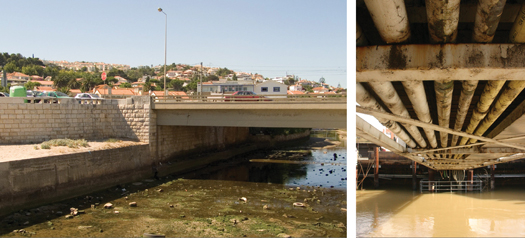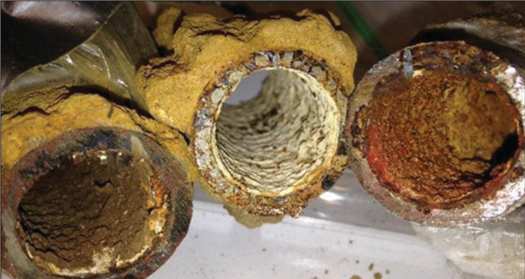What’s Wrong With America’s Water?
By Nisa Islam Muhammad -Staff Writer- | Last updated: Mar 30, 2016 - 9:53:01 AMWhat's your opinion on this article?

According to America’s Infrastructure “report card” issued in 2013 by the American Society of Civil Engineers, the categories of Drinking Water and Waste Water were given grades of D+ and D respectively. Photos: MGN Online
|
WASHINGTON—From rapidly vanishing ground water to old, leaky pipes that waste billions of gallons of water across the country to aging corroded pipes that leak lead into the water system to climate change drought, America has problems with its water system.
“We really just aren’t prepared for the new normal that we already are experiencing; not enough water in some places and sometimes too much in others,” explained Alice Hill, special assistant to President Obama and a member of the National Security Council staff at the White House Water Summit, March 22.
“We need to do more to conserve the water we have, and we need to invest in that water infrastructure that rests below our feet,” she said. “We need to find new ways to work together to solve these problems.”
The National Water Summit brought together experts for discussions on the county’s growing challenges with water. The problems have become so severe that the White House is taking more responsibility for finding solutions and developing water policy.
Old infrastructure
“We waste seven billion gallons of water each day— water that we have treated and cleaned,” said Ali Zaidi, the associate director for natural resources, energy and science in the Office of Management and Budget. “Let’s get rid of the leaky pipes. Let’s unleash innovation.”

Samples of Flint Michigan water pipes showing various forms of corrosion.
|
Many in attendance agreed that repairing and replacing old infrastructure would solve many problems.
“Just fix the plumbing. You’ll save a lot of water,” said Victor Griego, a board member of Los Angeles-based Water Education for Latino Leaders.
In Flint, Mich. where high lead levels were found in the water after it was switched from the Detroit water source to the Flint River, replacing aging pipes is one of their top solutions that started March 4.
“The city has started replacing pipes but will only do 30 in 30 days,” community activist Audrey Muhammad told The Final Call. “There are 8,000 lead service lines and 33,000 homes and businesses affected. After 30 days, they will see what’s next. How is that going to help us?” she asked.
“We need someone to come here and help us pull this all together. Engineers want to come and help us. The entire infrastructure needs to be replaced. We need help.”

|
“The reality of this situation doesn’t hit you until you’re there and see exactly what the people are going through. That’s what I saw when I went there. The people of Flint just want clean water and more importantly they want hope for their community.”
Problems nationwide
Lead in the water is also a problem in Newark where during annual water testing, March 7, elevated lead levels were found in 30 schools. Until further notice, Newark Public Schools will utilize alternate water sources for drinking and food preparation.
“I understand in the Flint environment that any sign of elevation is going to make everyone go haywire, but here, the water system in Newark is still safe, it’s still drinkable,” the city’s mayor, Ras J. Baraka, said at a press conference, March 9.
According to America’s Infrastructure Report Card last issued in 2013 by the American Society of Civil Engineers, the categories of Drinking Water and Waste Water were given grades of D+ and D respectively.

|
The problem of how America manages its water from one department to another was a concern for many at the Water Summit. “We don’t have a single water agency in the federal government. We have water housed all over the place,” said Rep. Jared Huffman, a California Democrat. “The way we’ve balkanized water at the federal government is not helpful in terms of promoting consistent, coherent, leading-edge solutions to our water problems.”
The Administration is proposing a range of solutions that include :
Nearly $4 billion in private capital committed to investment in a broad range of water-infrastructure projects nationwide. This includes $1.5 billion from Ultra Capital to finance decentralized and scalable water-management solutions, and $500 million from Sustainable Water to develop water reclamation and reuse systems.
“One of the greatest challenges we face is dealing with the impacts of climate change on our nation’s water, which is really the lifeblood of our economy,” said Interior Deputy Secretary Michael L. Connor in a press statement.
“We need to continue to develop collaborative strategies across each river basin to ensure that our nation’s water and power supplies, agricultural activities, ecosystems, and other resources all have sustainable paths forward.”
Back in the 1960s and early 1970s, the patriarch of the Nation of Islam, the Honorable Elijah Muhammad, warned about the danger of impure water and chemicals added to water. “Some water is poisonous for us to drink. There is water even in Chicago that is not good for our health. It is not pure enough. Water should be at least 99 percent pure in order for it to be good for humans to drink,” he warned in “How To Eat To Live,” which was published in 1967.
In another chapter, in this important book, he wrote, “Poisonous food and water we are now eating and drinking – sometimes too much poison to kill poison that is in our food and drinks. And, maybe it is the wrong poison for us human beings, whether it is in food or in drinks. Take, for instance, the use of fluoride, chloride, and sodium, which if not used correctly can destroy our entire life. Maybe it is best to find something else that will clear our water without killing both us and the poison in our food and water. The scientist should not advocate the use of such poisonous chemicals as fluoride, chloride, and sodium, which may have a bad effect on our brains and our human reproductive organs. The scientist that uses such poison on human beings wants to either minimize the birth rates or cause the extinction of a people.”
INSIDE STORIES AND REVIEWS
-
-
About Harriett ... and the Negro Hollywood Road Show
By Rabiah Muhammad, Guest Columnist » Full Story -
Skepticism greets Jay-Z, NFL talk of inspiring change
By Bryan 18X Crawford and Richard B. Muhammad The Final Call Newspaper @TheFinalCall » Full Story -
The painful problem of Black girls and suicide
By Charlene Muhammad -National Correspondent- » Full Story -
Exploitation of Innocence - Report: Perceptions, policies hurting Black girls
By Charlene Muhammad -National Correspondent- » Full Story -
Big Ballin: Big ideas fuel a father’s Big Baller Brand and brash business sense
By Bryan Crawford -Contributing Writer- » Full Story






 Click Here Stay Connected!
Click Here Stay Connected!








